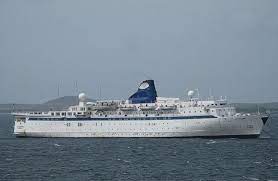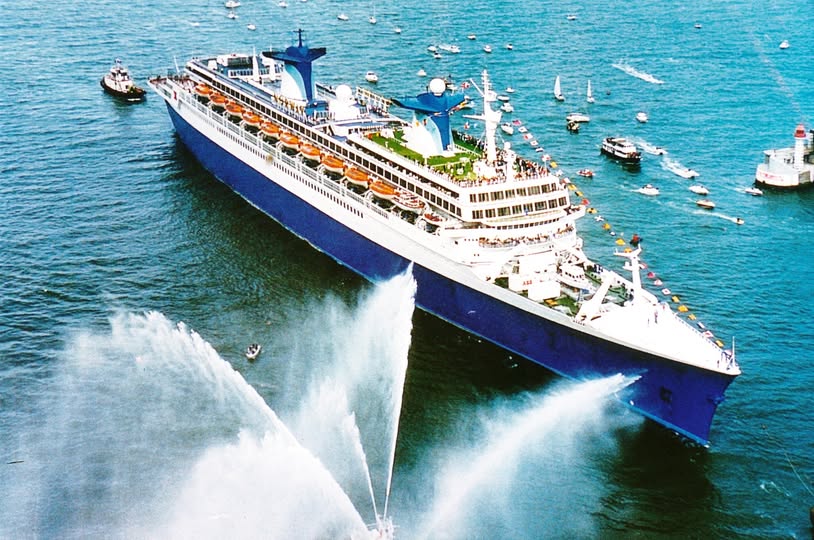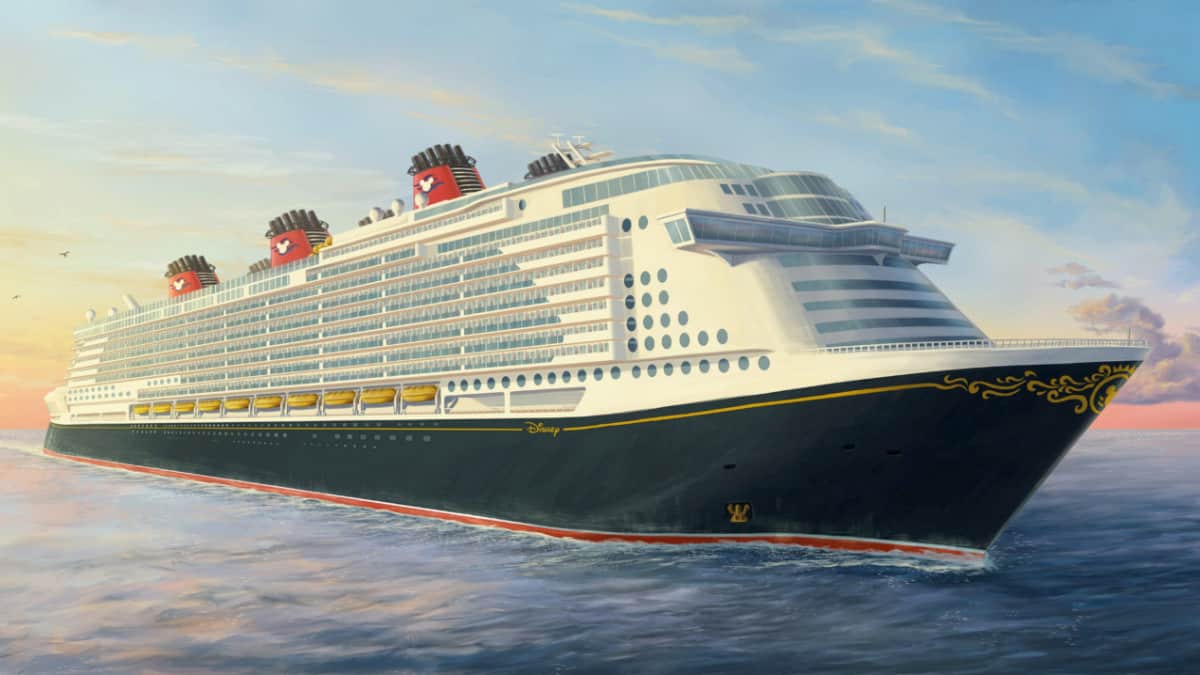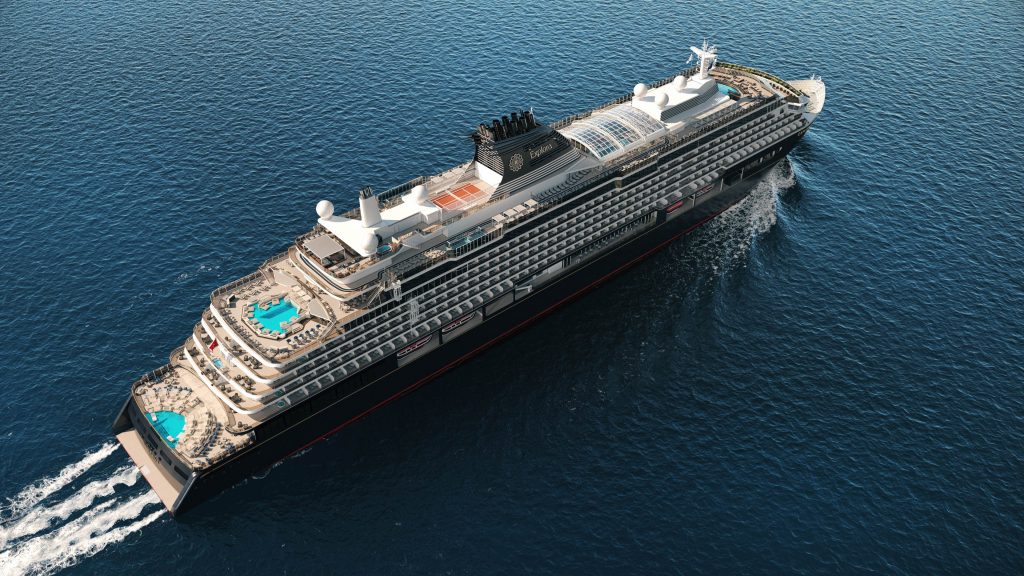In March 1976, I was just 14 years old at the time, I was allowed to visit my first cruise ship, the Black Prince. It literally changed my life, once on board this intimate little ship I was immediately addicted to passenger ships and cruising which today, at the time of writing 44 years later hasn’t changed!
Have a look at the photographs I took back then: Black Prince photo-page
Black Prince was built at the Flender Werke in Lubeck, Western Germany, yard number 561, and was launched on May 14, 1966. She was ordered by Frederik Olsen & Co. from Oslo, Norway, with accommodations for 693 passengers and 200 cars during ferry service, but in cruise service she was sailing with just 330 passengers. With a length of just 141 meters, a beam of 20 meters and a draft of 6 meters, she was a small vessel by today’s standards. She measured 9499 GRT and was a sister ship to Black Watch which been launched two months earlier.

The first vessels in the fleet of Fred Olsen, a sailing ship and a steamer were called Bayard, and ever since, Fred Olsen ship names start with the letter “B”. Before the second World War, two new ships were called Black Prince – to honour England- and Black Watch – to honour Scotland. Unfortunately both ships were lost during the war. So Black Prince of 1966 was the second vessel to bear this name. Black Prince (born 1330) was Edward of Woodstock, son of King Edward III and he became famous for his victories in battle. The “black” refers to the black livery he and his servants wore, his “Shield for Peace” bore a black background beneath three ostrich plumes and his motto ‘Ich Dien”, meaning “I Serve”.
Black Prince was used from October to May in cruise service (as well as carrying freight) from London to the Canary Islands for Fred Olsen while another Norwegian ship owner, Det Bergenske operated her as a ferry during the summer months between Kristiansand and Harwich as well as on the Kristiansand – Amsterdam run.

This continued for a couple of years until May 1970 when another form of collaboration between Fred Olsen and Det Bergenske Dampskipsselskab was agreed upon. From now on she was renamed Venus when Det Bergenske operated her between Bergen – Stavanger – Newcastle during the summer season, while during the following winters she reverted to her original name of Black Prince for cruise service from Rotterdam to the Canary Islands. With just some simple interior changes she could be transformed from a ferry to a cruise ship in a matter of days.
Under the same agreement her sister Black Watch was renamed Jupiter when sailing for Det Bergenske in ferry service between Bergen and Newcastle while switching back to Black Watch while cruising from London to the Canary Islands in winter.


This pattern would continue until 1985 and this period was quite uneventful apart from engine problems in 1973 after one of the ship’s propellers hit the seabed.
However, after 1982 she was operated by another ferry operator, DFDS from Denmark, for the following four years on the route from Newcastle to Bergen and Stavanger as well as to Esbjerg. This was interrupted only in 1985 for two charters in May for the National Trust of Scotland cruising to Leith – Norway – Iceland – St Kilda – Arran – Glasgow followed by a short trip for the Glasgow Herald sailing from Glasgow to Torquay before she was deployed on yet another ferry route for Norwegian ferry operator Norway Line between Bergen – Newcastle that same year.

Then, Fred. Olsen sold sister ship Black Watch to Norway Line who used her for North Sea ferry service under the name of Jupiter, the name she had sailed under during the summer seasons in the same scheme that had been agreed upon with Det Bergenske for her sister Venus.
They did not dispose of Black Prince which was now from 1986 onwards fully owned by Fred Olsen (actually registered for Vinta Maritime Co Inc, Manilla) and they had her rebuilt as a fulltime cruise ship by Wartsila Yards, Turku, Finland between October 1986 and February 1987. The company had investigated the market for tourism at the time and saw a very strong increase in demand for cruising, mostly in the US, but Europe also saw a promising growth of 10% yearly. The Black Prince had a loyal following now as the past 17 winter seasons had been a great succes with a solid 90% occupancy rate on average. But it was decided to have the ship rejuvenated after 20 years of service in such a way that she could offer a special experience in the future. So an 18 meter long structure of floating jetties the Marina Park was attached to her stern being the entrance of her former garage during her ferry days, enabling her passengers to practise a number of different watersports like diving, snorkeling etc. The aaverage age of passngers had been around 55 up till now and it was expected this would drop to 40 years.

Her tonnage grew to 11.500 GRT and she now had a max. capacity for 527 passengers (444 lower berth) looked after by 145 crew. Fares started at 560 pounds for a berth in a family cabin to 2830 ponds per person in a suite for a 13-day cruise. 80 Cabins were added in her former garage, she offered 12 suites, 177 outside cabins and 65 inside cabins. Her cruise schedule was now year round, not only limited to the Canary Islands but the Mediterranean and Northern Europe were also included. There were now three restaurants, Marquee (outside on Marquee deck), Royal Garter and Fleur de Lys both on Lounge deck, the inside restaurants had now dropped the fixed meal times, giving passengers more flexibilty. Fleur de Lys was situated in her former card room which in turn had been moved to where the Garden Lounge used to be. She also featured a shopping mall, casino, library, card room, hospital and a fitness centre (comprising a gym, suana, solarium, hairdressing salon and a juice bar, all situated in the former cargo hold). Her outside deck aft was enlarged and a new pool was fitted. Lounges and bars were reconfigured and redecorated too, the Neptune Lounge now opened up to the Lido Lounge by removing her former indoor pool (which had been quite unusual for a ship her size), now creating a multifunctional space. Together with the Aquitaine Salon this resulted in considerably more seating space. On her top deck even sails were added to give her the appearance of a yacht like cruise ship.

She started in her new role with a series of cruises from Southampton to the Mediterranean/ North Africa and over time became a very popular and well-known cruiseship. Passengers often still were elderly people, enjoying her intimacy and the cordial friendly atmosphere on board she was soon known for. In fact she was the only ship operated by Fred. Olsen after they had sold their other two vessels (ferries) in 1991.

By now her Philippine registry and the fact that she sailed with a largely Philippine crew began to cause problems. In May 1989 following a strike by the Philippine crew she was transferred to the Norwegian International Ship Register (NIS) with Oslo as her new homeport.

Alas, problems were not over when during her 1990 cruise season when sailing on cruises between Gothenburg and Copenhagen, the Swedish Seamen Association (followed by the Danish one) strongly protested that Fred Olsen operated a ship with an underpaid Filipino crew. This resulted in port calls in Gothenburg being disrupted with people protesting, and even port workers joined, resulting in Black Prince being taken out of service and being laid up in Oslo.
Six years later however, she left Norwegian registry and was transferred to the Bahamas flag with home port Nassau, Fred Olsen now being a Bahama’s registered company, Fred Olsen Cruise Lines Pte Ltd, Nassau, changing its name to Black Prince Cruise Limited, Nassau in 2007.
In 2008 problems arose with the new SOLAS rules to be implemented in 2009 as it would cost a vast amount to upgrade the now ageing little ship to meet these new safety standards and Fred Olsen decided she had to leave the fleet. May 2009 she was sold to Servicios Acuaticos de Venezuela CA (SAVECA), Venezuela and in September/ October 2009 Black Prince made her last cruise for Fred Olsen. Although now being an old ship she still was an immensely popular vessel. Passengers accepted her small and after all these years and upgrades still small and austere cabins

remaining from her ferry days while fares were quite high and her large following was sad to see her go. At the end of her career with Fred Olsen she had been useful opening up new destinations, being a small ship, as just over 200 cabins needed to be filled so the company did not run too much of a financial risk.
In 1995 Fred Olsen had acquired the former Royal Viking Star which they renamed Black Watch which was followed by Braemar in 2001 (ex-Crown Dynasty), Boudicca in 2005 (ex-Royal Viking Sky) and finally Balmoral in 2007 (ex-Crown Odyssey), all larger and more luxuriously appointed ships having been refitted before entering service for Fred Olsen. Black Prince didn’t really fit in the fleet anymore.

In November 2009 she left Southampton for Venezuela, her name having been shortened to Prince. Her new owners SAVECA (owned by a group of Venezualan hotel chains) immediately renamed her to Ola Esmeralda and at first planned to operate her on cruises into the Caribbean from Venezuela, but several destinations in the Caribbean refused her because of the now internationally impopular administration of president Hugo Chavez she was linked to (SAVECA was able to buy fuel for her at favourable prices from the Venezuelan government, Venezuala being an oil rich country). Itineraries ranging from three- to five nights calling at various ports in Venezuela, Aruba, Curacao and Trinidad and Tobago had orginally been planned.
Also, she did not get the required certificate and she would now remain in coastal waters of Venezuela avoiding having to meet stringent safety rules for deep sea passenger vessels.

However before these coastal cruises to have her generate at least some income she was chartered to a Mexican oil company to become a housing vessel for their workers and later to a second charter followed to the U.N. to be a housing ship in Haiti after the devastating earthquake that had struck the island.
It was reported that in March 2011 Ola Esmeralda cruised from La Guaira, departing day 1 at 18.00 hrs, on day 2 she called at Puerto La Cruz, on day 3 at Margarita Island and retruning to La Guaria on day 4.
June 2011 the SAVECA website showed Ola Esmeralda being out of service for a couple of weeks for a short refit before returning to sail a next series of coastal cruises.
It is somewhat confusing as other reports mention she did not sail at all in cruise service for SAVECA…

Anyway, her new life in the Caribbean did not last long, as in November 2012 Ola Esmeralda was listed as being for sale and was advertised with an asking price of $ 2.75 million. It was mentioned she was still able to sail using her own machinery. Weeks later SAVECA ceased operations and with no parties intrested in the old, not SOLAS compliant ship, she was sold for scrap.
She was scrapped at Santo Domingo, Dominican Republic in October 2013.




